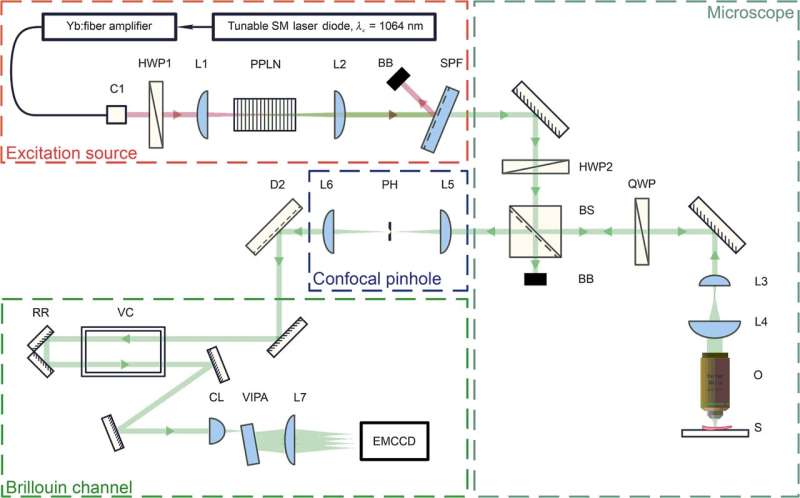This article has been reviewed according to Science X's editorial process and policies. Editors have highlighted the following attributes while ensuring the content's credibility:
fact-checked
peer-reviewed publication
trusted source
proofread
Brillouin microspectroscopy as a noninvasive tool for evaluating vocal fold elasticity

The vocal folds, more commonly known as vocal cords, are small and flexible flaps of tissue located inside the larynx, better known as the "voice box." These delicate, multilayered structures assist in multiple functions, including breathing and swallowing. Most importantly, however, the vocal folds allow us to vocalize.
We can produce all kinds of sounds simply by controlling the tension and shape of these folds. Unfortunately, many diseases and anomalies can affect the mechanical properties of the vocal folds. Significant changes in the elasticity and viscosity of these folds can lead to voice loss or greatly hamper our ability to communicate properly.
Currently, all pathologies in the vocal folds are diagnosed using laryngoscopy and videostroboscopy. These techniques enable a visualization of the vocal folds in action, providing clues to any underlying condition. However, there is currently no way to objectively measure the mechanical properties of the vocal folds and obtain a definitive diagnosis without performing a biopsy, a risky procedure that can lead to unintended adverse effects on the voice.
To address this issue, a research team from Texas A&M University and University of Southern California is developing a noninvasive way to analyze the mechanical properties of the vocal folds. In their new paper published in Journal of Biomedical Optics, the team demonstrated the untapped potential of Brillouin microspectroscopy, an emerging optical imaging modality that holds much promise for the diagnosis of vocal fold pathologies.
The proposed methodology is based on the principle of Brillouin scattering—an optical phenomenon in which light interacts with sound waves in a material to generate mechanical oscillations. This causes a small shift in the frequency of light reflected off the surface of the material depending on the material's elasticity.
In their work, the researchers developed a custom microspectroscopy setup that was optimized to measure Brillouin scattering in vocal fold tissues. To test their approach, they performed a series of measurements on vocal fold samples from porcine larynxes and calculated the elastic properties of the samples based solely on the Brillouin frequency shifts. They then compared the estimated values with those obtained in previous studies using conventional elasticity measurements.
Overall, the team found good agreement between the results obtained from both measurement approaches. Using the Brillouin microspectroscopy setup, they managed to accurately measure the differences in stiffness between the superior and inferior vocal folds. Additionally, they could tell apart various laryngeal substructures from the surrounding tissue based solely on the observed Brillouin frequency shifts: the supraglottal wall tissue displayed the highest shift, while the superior vocal fold displayed the lowest.
The findings of this study thus indicate that Brillouin microspectroscopy could become a valuable tool for laryngologists in the future. The proposed imaging platform can be made compatible with modern endoscopy systems regularly used by professionals to observe the vocal folds. This, in turn, could open doors to noninvasive and remote measurements of vocal fold pliability and, accordingly, new diagnostic standards.
More information: Vsevolod Cheburkanov et al, Porcine vocal fold elasticity evaluation using Brillouin spectroscopy, Journal of Biomedical Optics (2023). DOI: 10.1117/1.JBO.28.8.087002 www.spiedigitallibrary.org/jou … JBO.28.8.087002.full




















